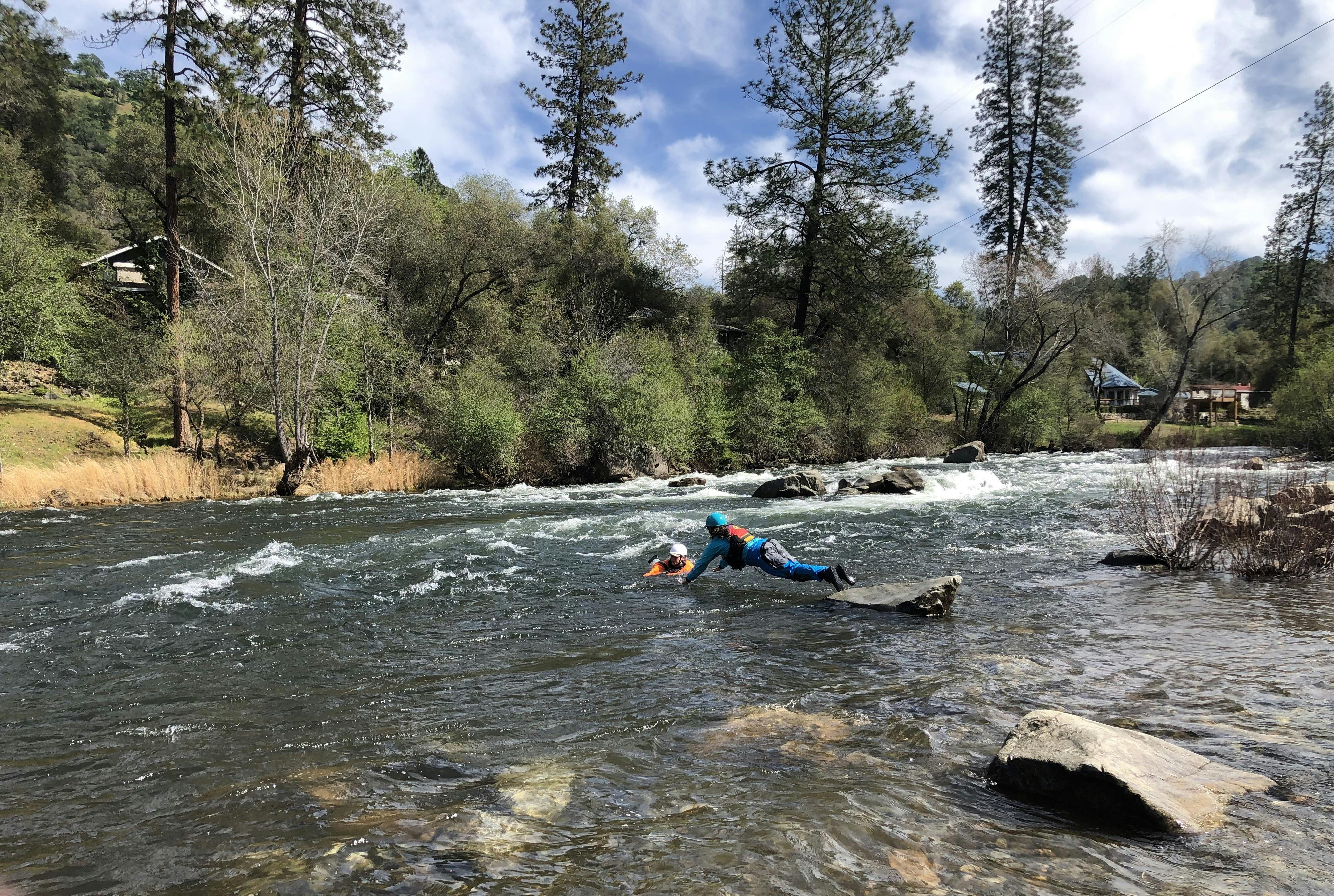Back on the Water - Part Three

As I approached my boat after completing a scout of the class III rapid, I did a quick assessment of my current mental state. I was dysregulated and feeling quite anxious. In fact, my rational brain knew that the level of fear and anxiety I felt far outmatched the current situation once I took into account my paddling ability and the difficulty/risk of the rapid. From my trauma resolution training, I know that when this happens (our body’s response to something in our environment seems like an overreaction), it is a trauma response. Recalling other similar situations, I knew that my level of anxiety would impact my ability to perform well and paddle the rapid safely. I needed an intervention, and I carried it out, which allowed me to successfully and safely make it through the rapid (you can learn this tool through the video I created here).
In Parts I and II of this series, we discussed what causes trauma/stress injury and how to apply psychological first aid to minimize its effects directly following a potentially traumatizing incident. However, we’ve all lived some life and had plenty of adventures before we may have known all this; so in Part III, we’ll cover symptoms of trauma, how to heal from trauma, and other resources.
Symptoms of Trauma/Stress Injury
The list of potential symptoms of stress injury is long, and just because you might see something on the list that you experience from time to time, or regularly, doesn’t necessarily mean the cause is from trauma. One rule of thumb I follow is as my scout illustrated above: when it seems there is disproportionately reactive behavior to a stressor, it is likely caused by trauma in our past - whether we can recall the event in our explicit memory or not. Of course, there will be some level of stress, anxiety, or fear before navigating a (relatively) dangerous activity. This is normal - fear is simply the body’s signal that we need to pay attention as we are in a potentially life threatening situation if we don’t act appropriately. It’s up to you to know yourself well enough to determine if the level of stress you’re feeling is going to impact your performance in an unsafe manner.
Trauma symptoms don’t always show up directly after the event. Some do, but many may not appear until 6+ months later. After my first big swim caused by that rogue lateral, I obviously didn’t learn my lesson and went out on big water again a few weeks later. It wasn’t until the next boating season that the traumatic symptoms were strong enough to impact my willingness to get back on the water.
Trauma also has a cumulative effect in the body. Our system will absorb overwhelming stressor after stressor and we are seemingly fine, until one day, a seemingly small event can trigger a cascade of trauma symptoms - the metaphorical straw that broke the camel’s back.
There is one primary factor that determines our ability to face stress: the resilience of our nervous system. 10 people can experience the same event and some may simply walk away with an unpleasant memory and emotions but no trauma while others develop mild to severe symptoms of trauma. Below is a list of common symptoms of trauma, though it is by no means exhaustive:
- Anxiety and/or panic attacks
- Avoiding places, activities or people that remind you of the traumatic event
- Flashbacks, intrusive thoughts, nightmares, night terrors
- Chronic pain
- Syndromes (IBS and Fibromyalgia, for instance)
- Tension
- Hyperarousal and/or hypervigilance
- Dissociation
- Feeling helpless
- Exaggerated emotional or startle responses
- Mood swings
- Trouble sleeping
- Feeling stressed out more easily or frequently
- Difficulty concentrating
- Chronic fatigue
- Depression
- Psychosomatic illnesses (they seem to have no known cause that can be addressed)
- Disconnection from family and friends
Healing from Trauma
Here’s the best part: no matter how severe trauma symptoms might be for someone, there is hope. For instance, Somatic Experiencing® (SE™) is highly effective for combat veterans with PTSD. It is just as effective in working with less complex trauma.
There are two main components to address when healing from stress injuries. The first is to build resilience in the nervous system and once a solid baseline is there, the second is to complete the threat response cycle that was thwarted. This is not easy to accomplish alone. I encourage anyone being impacted by trauma symptoms to work with a reputable, trauma-informed provider - whether a psychotherapist, body worker, counselor, Somatic Experiencing Practitioner (SEP), or somatic coach, to work with the issue. I stress “reputable” as many older trauma “healing” methods (such as exposure therapy) are retraumatizing and cause more harm than good. Here is a link to a list of providers around the world who are trained in Somatic Experiencing®, a highly effective trauma resolution technique.
Help Yourself Heal
If working with a specialist is out of reach for you, here are a few things you can do on your own:
Firstly, regardless of your trauma history, I challenge everyone reading this to spend at least 60 seconds each day taking in some pleasurable aspect of life. It could be the sight/smell of a flower, listening to children play, cuddling with a pet, or feeling the sun on your face. Don’t just take in the sensory experience, it is essential to also notice the sensations in your body as you do so. Ask yourself, as you gaze at the river bathed in sunset as it runs out of the distant mountains, “How do I know that I am enjoying this moment? What are the sensations in my body that let me know this is ‘good’?” Once you’ve identified those sensations, spend the 60 seconds feeling into the good feelings in your body.
It’s not enough to just witness beauty - you must integrate it into the body and nervous system with intention and awareness. And if you can’t locate any sensations? Don’t give up! Our society does not support us listening to our bodies. We are taught to override what our body is telling us, ignore its signals and instead, go faster-harder-stronger-longer despite our body crying out for rest, nourishment, sleep, or a change of pace. So stick with it the same way you would with any new skill: expect to first suck at it, and then work with it until you are proficient. This is the essential first step in building a more resilient nervous system. Our human brains have a negativity bias, so, left to our own devices, we will not notice the good and pleasurable.
Secondly, you can work through completion of the threat response cycle on your own, sometimes. For instance, if you’re telling the story of the Scary Swim for the umpteenth time to a new paddling friend, notice the sensations that are occurring in your body. Is there any shaking or trembling? Great, let that happen and sit with it as your body discharges some of that leftover energy. You might even share it with your friend. “Oh interesting! I’m noticing as I tell you this story that my hands and voice are trembling.”
Lastly, make sure you connect with supportive friends or family about the ordeal. Having someone to listen and support you as you navigate the various layers that time brings to the surface is invaluable; as is someone to sit right next to and make physical contact with - most nervous systems love that! You can sit side by side, making contact along the shoulder and arm; or if you’re comfortable, have them put their hand on your back or both shoulders (this helps co-regulate the nervous system).
Trauma Is Not a Life Sentence
Packrafting is my favorite activity in the world. Being on the water is also dangerous and trauma in our community is more prevalent than I had suspected. If there’s one thing I wish for you to walk away with, it’s hope knowing that trauma and its symptoms don’t have to be a life sentence. It is my deepest desire to be of service to our community and that this series has been informative and helpful to you. If you love to geek out on this type of science as much as I do, my resource page is a good place to start your deep dive. Don’t hesitate to reach out with any questions. Wishing you safe and happy paddling!
About the Author:

Julia Yanker is an adventurer and Somatic Coach specializing in trauma resolution who has received 4 years of training in the technique of Somatic Experiencing®, a trauma resolution modality used around the world to help people heal from trauma. She lives in Bozeman, Montana, and jokes that she has participated in every adventure sport at least once (besides the ones that involve jumping off or out of things). She mostly spends her time packrafting, horseback riding, camping, foraging, and skiing. You can learn more about her work on her website or follow her on Instagram.